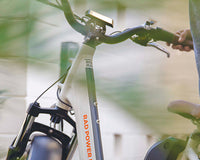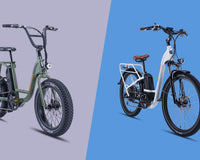Guest post from Marley Blonsky.
I’ve been using my bike to go camping since 2015, and it’s one of my favorite ways to spend a weekend. I’ve written about my bike camping adventures before, but realized recently that I’ve never had a chance to go with an electric bike.
I decided to change that.
The urge struck me on a Friday morning. I woke up to a bright blue sky, logged onto work, thought about my upcoming weekend with yet again no plans (thanks COVID), and realized “I can go camping. I can go tonight. Holy cow, I can take my new RadCity Step-Thru!”
It was the kind of impulse I’m no stranger to. Luckily, a bike makes it a lot easier to follow through with those last-minute decisions.
If you’re feeling the itch to spend a day on your electric bike followed by a night under the stars, here are a few tips.
1. Make a Plan.

If you’ve only accessed camping via car before, there's a lot to think about ahead of time. How will you get to the campground? Are the roads high speed or are they lower speed and friendly to cyclists? Are there wide shoulders that are safe for you to ride on? Are there bike trails? This is a scenario where a little bit of research can go a long way.
I’m fortunate to live in Seattle, where there's a multitude of easily-accessible camping options available, so I decided to go to Kitsap Memorial State Park, which is about an 18-mile ride from Seattle with a lovely half-hour ferry ride in the middle.
2. Pack smart.
My next step was to pack my gear. I was only planning for one night, so I packed light: a sleeping bag, a small tent, my stove, some bike repair tools, a toiletry kit, and a book.
All my gear fit nicely into my two rear panniers. My RadCity Step-Thru has the large front basket installed, which I used to haul a load of firewood once I got to camp, but otherwise my bag easily handled everything else.
Just remember that a lot of factors go into how long the battery lasts, including cargo weight.
3. Scope out the right site.

Camping is especially popular this summer and I’ve found that nearly all the sites that can be reserved, are reserved.
Luckily, many states have dedicated first-come-first-served “Hiker/Biker” spots specifically for people who arrive by foot or bicycle.
In all my years of bike camping, I’ve never once been turned away, even from a full campground. Turns out, when all you carry with you fits on your ebike, it’s a lot easier to share space with additional campers!
4. Plan for a recharge.
Knowing that I could get a full charge on my battery before coming back home on Saturday was crucial.
Shortly after arriving, I found the Park Ranger and explained that I had arrived to camp on an electric bike. I asked if there was a secure place where I could charge the battery and he was more than happy to help out. We took it to the ranger station to charge for a few hours and made a plan to meet up once it was good to go.
Of course, if you're not in the mood to make new friends on-the-fly, just call ahead to check if the site has electricity available or if there's a nearby spot where you can plug-in!
5. Relax! Your bike’s got your back.

The ride to the campground on my usual, non-electric bike normally takes me 3 to 4 hours, with a few rest-stops along the way.
If I told you I made it to camp in 2 hours on my RadCity Step-Thru, would you believe me? Well, it’s true.
I got there with both energy in my body and energy in my battery to spare! It was a pure delight to show up to camp, settle into the site, and have my body feel good instead of exhausted. I set up camp, made dinner and watched the sunset on the longest night of the year over the Salish Sea.
The next morning, I woke up refreshed and excited to ride back home.
On the return trip, I ran into a few friends who had also gone bike camping overnight. We chatted as we rode together back to the ferry, swapping stories about our adventures and plans for our next trip!
Marley Blonsky is a nationally recognized activist committed to challenging cycling's body image problem. Her mission is to widen the perspective on who belongs on a bicycle by using herself and her own powerful body as an example. For more info, check out her blog or read her profile on the Scenic Route.






